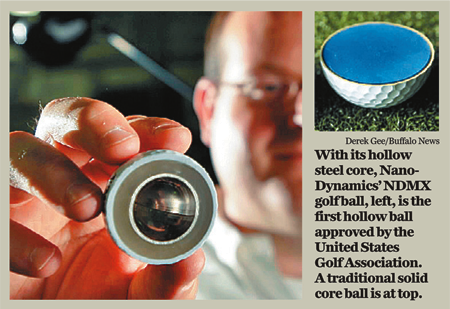 |
| A CURE FOR THE COMMON SLICE Buffalo company creates a hollow golf ball designed to fly straight and stay near the fairway BUFFALO NEWS Saturday, June 10, 2006 Section: News Page: A1 The prayer of golfers everywhere -- please, let me hit it straight -- may have been answered right here in Buffalo. Inventor Doug DuFaux and his employer, Buffalo's NanoDynamics Inc., believe the hollow golf ball they have developed and are now selling by the thousands online could be the answer to golfer frustration the world over -- for the hefty price of $60 a dozen. The NDMX ball, with a Buffalo-welded steel sphere inside a dimpled white cover, stays closer to the fairway when hit off-kilter. Normally, hooks and slices send balls into the woods, sand and water. But NanoDynamics says its golf ball, unlike ordinary balls, does not curve as much as other balls do. It also doesn't fly quite as far when hit straight on. For an average golfer it may go 10 yards less. Yet the prospect of getting a better score and not going as deep into the woods despite a bad shot has created a demand for the first-ever hollow ball. And it has been approved by the United States Golf Association. "Eventually we think most golf balls will revolve around the hollow metal core," said DuFaux, the director of innovations at NanoDynamics, whose headquarters is inside the old Ford Model T plant on Fuhrmann Boulevard. "It's really designed for people who have trouble controlling their hook and slice." Since the ball he invented with a friend went on sale in November, more than 10,000 have been sold to golfers in Japan, South Africa and the United States. In February, DuFaux said the USGA hesitantly approved the odd ball because it met rules for weight, size, sphere symmetry, velocity and distance. Now DuFaux, his South Carolina-based co-inventor Tim Owens and the company's team of collaborators are working to make the next version of the ball go farther. The company is also talking to undisclosed big golf names -- Titleist and Nike are famous ball makers -- as it considers a partnership. For now, balls are being made in stages by other manufacturers, with one welding the metal core, for example, and another handling the hard plastic coating. The golf-ball market, estimated at $1 billion a year, is part of the $4.5 billion equipment market for the 25 million golfers in the United States. Almost a decade has gone by since DuFaux and Owens, both engineers, were having a few drinks at a North Carolina bar when one of them wondered if a hollow ball might improve the game DuFaux had just become addicted to. His tendency to hit the ball with a curving hook that sent it flying off the fairway was frustrating. Incredibly so. Now DuFaux, 35, who has been with NanoDynamics for three years, doesn't remember which one of them said hollow. He also doesn't have time for golf. "We always talked about how great it would be to be in the golf business," DuFaux said of long-ago conversations with Owens, the full-time nano ball consultant who introduced DuFaux to the game. They met when they were working in Washington, D.C., in the government office charged with developing manufacturing standards. "Being the nerds that we are, we talked a lot about spin," he said of the turning force that controls ball direction and height. "We were just fascinated with the spin of the ball and how to control spin." Their logic for a hollow ball: The weight would be concentrated on the sides and not the center, as it is in typical solid balls. Like a spinning figure skater who slows herself by extending her arms, a ball with its weight out on its sides could spin less. This, the two young men conjectured, would make the ball fly straight. The hollow ball, which now has three patents and more pending, has been refined in the years since DuFaux joined the investor-funded technology company and proposed its development. And while NanoDynamics just received $2 million from the government to develop a fuel cell generator to run on methane gas from sewage plants, the nano golf ball is the 3-year-old company's first product on the market. "This is another step in the history of golf ball construction," said Frank Thomas, who for 26 years was in charge of testing and approving new golf equipment for the USGA. Thomas, who retired in 2000 and has been a consultant for NanoDynamics, explained how ball centers have evolved from feathers to rubber to plastic in the 500-year history of the game. "I don't play with the hollow-core ball because we're still working on perfecting it," said Thomas. People who have fast swings -- Tiger Woods has a club speed of about 125 miles an hour -- and can control the flight of their ball want their shots to go as far as possible. Many other golfers -- that is, most amateurs -- crave the straight shots that NanoDynamics says its ball can provide. One morning this week, Tim Fries, regional president of the Professional Golfers' Association of America, tested a few NDMX balls at Transit Valley Country Club in East Amherst, where he works as head golf professional. His first ball -- the $4 Titleist Pro V1 he prefers -- made a soft click when he hit it and soared over the fairway like a kite caught by wind. It landed about 290 yards away, about 30 yards farther than the nano balls that made metallic pops. The potential appeal of hollow balls makes sense to him. Balls that stay on the course might encourage some players to feel less frustrated. "It might bring more people to the game," said Fries. "If that ball got you out because you played more, I'm all for it." |